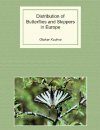World / Checklist Distribution Atlas
By: Otakar Kudrna(Author)
364 pages, 2 colour photos, 400+ colour distribution maps
![Distribution of Butterflies and Skippers in Europe Distribution of Butterflies and Skippers in Europe]()
Click to have a closer look
About this book
Customer reviews
Related titles
Recommended titles
About this book
Language: English
Twenty-four years have passed since the announcement and beginning of the project Mapping European Butterflies (MEB) back in 1995. The first results of the project were published in 2002 as The Distribution Atlas of European Butterflies (MEB-1). The late Prof. Dr. C.M. Naumann praised the Atlas as "a milestone in the history of European lepidopterology" – a commendation to be proud of. It was the first computer-aided distribution atlas of butterflies of any continent ever published. MEB was made possible thanks to an original recording method devised by the author. The second atlas, Distribution Atlas of Butterflies in Europe (MEB-2), appeared in 2011 and sold out in about one year. The third atlas, Distribution Atlas of European Butterflies and Skippers (MEB-3), was published 2015. The current Distribution of Butterflies and Skippers in Europe (MEB-4) completes the fourth phase and will be the last one involving the work of author Otakar Kudrna.
The Atlas is based upon the unique MEB data bank. It contained a 250,000 data records in 2002 (MEB-1), over 650,000 data records in 2011 (MEB-2) and contains over one million primary data records now, aggregated for efficiency down to nearly 400,000 working data records. The atlas contains distribution maps and tables of the 445 species of European butterflies and skippers (day-flying moths of the family Hesperiidae) as well as coincidence maps evaluating the distribution patterns from various points of view including zoogeography and conservation biology. The data contributed by nearly 300 recorders and country coordinators from all over Europe cover over 90 % of the territory. Of the total of 445 species 43 species are rare endemics each of which inhabits less than 0.269 % of Europe.
Highlights and new features of the atlas are:
- The atlas has grown to the present 364 pages of A4 size.
- It contains over 400 new distribution and coincidence maps based on a revised updated data bank.
- There are new detailed distribution tables for butterflies inhabiting the Macaronesian islands.
- The classification reflects the latest results including the new molecular research.
- The species accounts are updated and mostly rewritten: 10% of the butterflies are rare endemic species.
- The chapters on taxonomy and zoogeography are rewritten and expanded.
- Annotated synonymic checklists of species and genus group names contain over 1000 entries.
- The glossary is enlarged and partly rewritten, it contains over 300 entries.
- The bibliography includes over 300 references.
- The results and conclusions, analysed and discussed, enable recommendations for conservation.
- The book presents conservation priorities: Securing the habitats of rare endemic species, saving threatened species, restoring lost habitats of once common widespread species.
The significance of distribution data and maps is manifold. Butterflies are the ecologically dominant group of indicator organisms, the habitats of which are shared by thousands of insect species. The significance of butterflies for the conservation of nature on the whole is therefore immense and enhanced by their exceptional beauty. The loss of butterflies indicates the loss of inconspicuous insects. Butterflies can only be saved where they live. Thus knowledge of butterfly distribution is the first precondition for successful conservation. In spite of this, until the appearance of the first Atlas in 2002 there was neither a European data bank nor adequate distribution maps enabling an assessment their spatial status and the first marker of threat.
Customer Reviews



























